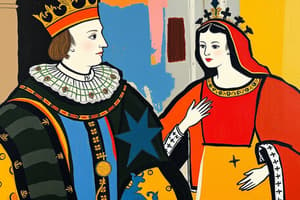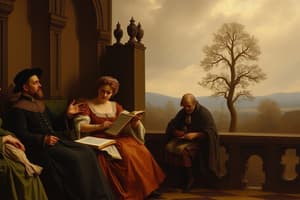Podcast
Questions and Answers
Who publicly denounced images in February 1547?
Who publicly denounced images in February 1547?
Nicholas Ridley
Somerset's cautious approach to religious reform began in _____ 1547.
Somerset's cautious approach to religious reform began in _____ 1547.
July
What was one of the main fears for Somerset when considering religious reforms?
What was one of the main fears for Somerset when considering religious reforms?
- The population embracing Catholicism
- Alienating Francis and Charles (correct)
- Increasing support for Calvinism
- Frustrating the lower clergy
The majority of the lower clergy and general population favored Protestant ideas.
The majority of the lower clergy and general population favored Protestant ideas.
What triggered some individuals in London to abandon the Mass?
What triggered some individuals in London to abandon the Mass?
Match the following figures with their roles or actions:
Match the following figures with their roles or actions:
What was a significant change mandated by the Royal Injunctions in November 1550?
What was a significant change mandated by the Royal Injunctions in November 1550?
Cranmer issued the Second Book of Common Prayer in 1552, which allowed for prayers for the dead.
Cranmer issued the Second Book of Common Prayer in 1552, which allowed for prayers for the dead.
Who was the archbishop responsible for producing the Second Book of Common Prayer?
Who was the archbishop responsible for producing the Second Book of Common Prayer?
During the Eucharist ceremony, the blood and wine were described as purely __________.
During the Eucharist ceremony, the blood and wine were described as purely __________.
Match the bishops to their fate during the religious reforms:
Match the bishops to their fate during the religious reforms:
What was the main purpose of the 42 Articles submitted by Cranmer?
What was the main purpose of the 42 Articles submitted by Cranmer?
The majority of churchwarden accounts indicate that the proposed reforms were not carried out in many churches.
The majority of churchwarden accounts indicate that the proposed reforms were not carried out in many churches.
What was a significant challenge in assessing the extent of Protestantism in England by 1553?
What was a significant challenge in assessing the extent of Protestantism in England by 1553?
The act of kneeling during the Communion service was clarified as __________ rather than worshipping an idol.
The act of kneeling during the Communion service was clarified as __________ rather than worshipping an idol.
Which foreign theologian heavily influenced Cranmer's work on the Second Book of Common Prayer?
Which foreign theologian heavily influenced Cranmer's work on the Second Book of Common Prayer?
What indicates the levels of enthusiasm for the reforms among congregations?
What indicates the levels of enthusiasm for the reforms among congregations?
Most people had a deep understanding of the reforms that were implemented.
Most people had a deep understanding of the reforms that were implemented.
What did Eamon Duffy suggest about people's attitudes towards their Catholic past?
What did Eamon Duffy suggest about people's attitudes towards their Catholic past?
People retained enthusiasm for Catholic practices until they were __________.
People retained enthusiasm for Catholic practices until they were __________.
Match the following statements with the appropriate conclusion:
Match the following statements with the appropriate conclusion:
What was a significant challenge in assessing religious reforms under Somerset?
What was a significant challenge in assessing religious reforms under Somerset?
Clergy members who refused to use the new services after January 1549 were punished by the government.
Clergy members who refused to use the new services after January 1549 were punished by the government.
What did Bishop Hooper discover regarding priests in his diocese?
What did Bishop Hooper discover regarding priests in his diocese?
Somerset's abdication resulted in the rise of ___, who purged conservatives from the council.
Somerset's abdication resulted in the rise of ___, who purged conservatives from the council.
Match the following individuals with their beliefs or actions:
Match the following individuals with their beliefs or actions:
Which of the following statements is true about religious reform under Somerset?
Which of the following statements is true about religious reform under Somerset?
The Book of Common Prayer explicitly denied the concept of purgatory.
The Book of Common Prayer explicitly denied the concept of purgatory.
After the council was purged of conservatives, what path did England follow under Warwick's influence?
After the council was purged of conservatives, what path did England follow under Warwick's influence?
The introduction of a new Ordinal in January 1550 caused ___.
The introduction of a new Ordinal in January 1550 caused ___.
What was a common criticism of Warwick’s religious reforms?
What was a common criticism of Warwick’s religious reforms?
What was one of the key changes enforced by the Royal Injunctions?
What was one of the key changes enforced by the Royal Injunctions?
The clergy were instructed to only preach in Latin.
The clergy were instructed to only preach in Latin.
Who authored the Book of Common Prayer?
Who authored the Book of Common Prayer?
The removal of censorship laws led to the publication of over ______ radical religious texts.
The removal of censorship laws led to the publication of over ______ radical religious texts.
Match the following practices to their corresponding changes:
Match the following practices to their corresponding changes:
What was one of the consequences of the Chantries Act?
What was one of the consequences of the Chantries Act?
Iconoclasm refers to the practice of maintaining traditional church decorations.
Iconoclasm refers to the practice of maintaining traditional church decorations.
What was the main focus of the April proclamation issued by Somerset?
What was the main focus of the April proclamation issued by Somerset?
The Book of Common Prayer reduced the number of sacraments to ______.
The Book of Common Prayer reduced the number of sacraments to ______.
Which event marked the significant removal of legal basis for Catholicism?
Which event marked the significant removal of legal basis for Catholicism?
Flashcards are hidden until you start studying
Study Notes
Religious Development Under Somerset
- Edward VI, influenced by evangelical beliefs, lacked the authority to direct ecclesiastical policy due to his young age.
- Somerset, showing sympathy for Lutheranism, welcomed reformers but did not aim for radical changes.
- Edward's regency faced the dual challenge of balancing reform with the risk of alienating Catholic allies like Francis I and Charles V.
- Evangelicals, returning from exile, raised tensions, particularly when Bishop Nicholas Ridley condemned images in early 1547, leading to some abandoning the Mass.
- Somerset adopted a cautious approach, issuing Royal Injunctions in July 1547 that reinforced and expanded upon previous injunctions, leading to iconoclasm.
- Key measures included forbidding church decorations, mandating the English Bible, and enforcing English preaching by priests.
- Enforcement of reforms was initiated through visitations despite opposition from conservative bishops like Gardiner.
- In November 1547, Parliament repealed the Act of Six Articles, signalling a legal shift away from Catholicism and allowing for the growth of radical ideas.
- The Chantries Act of 1547 dissolved chantries, raising funds for military campaigns, while indicating a push toward evangelical thought.
- By 1548, unrest grew as radical texts circulated, leading Somerset to reassert Catholic rites and restrict preaching to control the pace of reform.
- The Book of Common Prayer, issued in 1549, represented a significant liturgical change, but retained elements of Catholicism like vestments and holy days.
- Somerset's reforms appeared insufficient, splitting the public between reformers and Catholics, leading to mixed adherence to the new practices.
Religious Reform Under Northumberland
- Removal of Somerset in October 1549 resulted in increased division within England’s religious landscape.
- Northumberland allied closely with evangelicals, eliminating conservative voices from the council.
- His leadership marked a shift towards a stronger evangelical path, influenced by radical reformist ideas prevalent between 1547 and 1550.
- Initial reforms faced controversy, as seen in John Hooper's clash with Cranmer over ordination procedures and vestment requirements.
- Legislative changes in 1550 mandated plain wooden altars and surplices for priests, continuing the trend of iconoclasm established under Somerset.
- 1551 saw further consolidation of evangelical control, with conservative bishops removed and church valuables confiscated.
- The second Book of Common Prayer, introduced in January 1552, eliminated Catholic vestiges, affirming the commemoration of the Eucharist without transubstantiation.
- The Second Book, backed by strict laws, aimed to enforce conformity through harsh penalties for noncompliance.
- The 42 Articles were presented in 1552, reflecting strong evangelical doctrines, though they were never enacted due to Edward's death in 1553.
Religious Reform Under Edward – Assessment
- By 1553, England was officially Protestant with an evangelical majority among bishops and a Protestant king.
- Reforms signified the influence of continental reformers but faced internal resistance from the laity.
- Evangelicals like Bucer critiqued the pace of reform, suggesting that public adherence was superficial and old superstitions remained prevalent.
- Bishop Hooper noted the public's reluctance to fully embrace the new doctrines, highlighting simmering opposition to imposed changes.### Protestantism and Enthusiasm
- Only 20% of people in Protestant strongholds like London showed genuine enthusiasm for the movement.
- Regions like Lancashire, Staffordshire, and Worcestershire maintained strong Catholic roots despite Protestant reforms.
Pragmatism in Religious Practice
- Eamon Duffy highlights that most individuals acted pragmatically to survive, adapting to the forced changes rather than fully embracing them.
- Many people sold off their Catholic heritage when resistance became impractical but continued to practice Catholic rituals until they were outright banned.
Understanding of Reforms
- There was a general lack of understanding regarding the nature of religious reforms among both the laity and some clergy members.
- This confusion contributed to a pragmatic acceptance of changes rather than a heartfelt conversion to Protestant beliefs.
Indicators of Religious Sentiment
- Wills from various regions indicate differing levels of enthusiasm for Protestant reforms, reflecting a patchwork of acceptance across the country.
- The swift embrace of the Marian Restoration by congregations post-reforms indicates that, while they tolerated Protestantism, they were not genuinely converted to it.
Studying That Suits You
Use AI to generate personalized quizzes and flashcards to suit your learning preferences.




